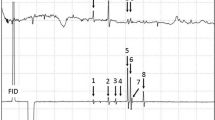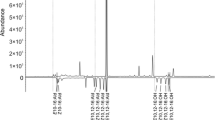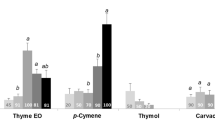Abstract
In the present study male redbanded leafroller (Argyrotaenia velutinana), cabbage looper (Trichoplusia ni), and Oriental fruit moths, (Grapholita molesta), were tested in a flight tunnel to (1) the major pheromone component, (2) theZ/E pheromone component mixtures for Oriental fruit moth and redbanded leafroller, (3) and the female-released blends, over a series of dosages. Experiments were designed to test the hypothesis that male response downwind of a female is initiated by the major component and that minor components function only to elicit behaviors close to the female during close-range approach and courtship. The results did not support this hypothesis, but rather showed that males initiated upwind flight in significantly higher percentages to the complete blends of components, at all dosages, compared to single components or partial blends. Addition of minor components also signficantly enhanced male perception of the major component at lower dosages, resulting in completed flights to dosages of the major component that alone did not elicit any upwind flight. Our results support the concept that minor components function to enhance male sensitivity to the pheromone, and the specificity of the signal. Our results also support the hypothesis that the active space of the pheromone is a function of the upper and lower concentration thresholds for the blend of components, and not simply for the major component.
Similar content being viewed by others
References
Baker, T.C., andCardé, R.T. 1979. Analysis of pheromone-mediated behaviors in maleGrapholitha molesta, the Oriental fruit moth (Lepidoptera: Tortricidae).Environ. Entomol. 8:956–968.
Baker, T.C., andRoelofs, W.L. 1981. Initiation and termination of Oriental fruit moth male response to pheromone concentrations in the field.Environ. Entomol. 10:211–218.
Baker, T., Cardé, R.T., andRoelofs, W. 1976. Behavioral responses of maleArgyrotaenia velutinana to components of its sex pheromone.J. Chem. Ecol. 2:333–352.
Baker, T.C., Cardé, R.T., andMiller, J.R. 1980. Oriental fruit moth pheromone component emission rates measured after collection by glass-surface adsorption.J. Chem. Ecol. 6:749–758.
Baker, T.C., Meyer, W., andRoelofs, W.L. 1981. Sex pheromone dosage and blend specificity of response by male Oriental fruit moths.Entomol. Exp. Appl. 30:269–279.
Berger, R.S. 1966. Isolation, identification, and synthesis of the sex attractant of the cabbage looper,Trichoplusia ni.Ann. Entomol. Soc. Am. 59:767–771.
Bjostad, L.B., andRoelofs, W.L. 1983. Sex pheromone biosynthesis inTrichoplusia ni: Key steps involve delta-11 desaturation and chain shortening.Science 220:1387–1389.
Bjostad, L.B., Gaston, L.K., Noble, L.L., Mover, J.H., andShorey, H.H. 1980. Dodecyl acetate, a second pheromone component of the cabbage looper,Trichoplusia ni.J. Chem. Ecol. 6:727–734.
Bjostad, L.B., Linn, C.E., Du, J.W., andRoelofs, W.L. 1984a. Identification of new sex pheromone components inTrichopulsia ni predicted from biosynthetic precursors.J. Chem. Ecol. 10:1309–1323.
Bjostad, L., Linn, C., andRoelofs, W. 1984b. Identification of new sex pheromone components inTrichoplusia ni andArgyrotania velutinana predicted from biosynthetic precursors, pp. 223–238,in T.E. Acree and D.M. Soderlund (eds.). Semiochemistry: Flavors and Pheromones. Walter de Gruyter, Berlin.
Bradshaw, J.W.A., Baker, R., andLisk, J.C. 1983. Separate orientation and releaser components in a sex pheromone.Nature 304:265–267.
Cardé, R.T., andBaker, T.C. 1984. Sexual communication with pheromones, pp. 355–383,in W.J. Bell and R.T. Cardé (eds.). Chemical Ecology of Insects. Chapman and Hall, London.
Cardé, R.T., Baker, T., andRoelofs, W. 1975a. Ethological function of components of a sex attractant system for Oriental fruit moth males,Grapholitha molesta.J. Chem. Ecol. 1:475–491.
Cardé, R.T., Baker, T., andRoelofs, W. 1975b. Behavioral role of individual components of a multichemical attractant system in the Oriental fruit moth.Nature 253:348–349.
Cardé, A.M., Baker, T.C., andCardé, R.T. 1979. Identification of a four-component sex pheromone of the female Oriental fruit moth,Grapholitha molesta (Lepidoptera: Tortricidae).J. Chem. Ecol. 5:423–427.
Elkinton, J.S., andCardé, R.T. 1984. Odor dispersion, pp. 73–92,in W.J. Bell and R.T. Cardé (eds.). Chemical Ecology in Insects. Chapman and Hall, London.
Klun, J., Chapman, O., Mattes, R., Wojtkowski, P., Beroza, M., andSonnet, P. 1973. Insect sex pheromones: Minor amount of opposite geometrical isomer critical to attraction.Science 181:661–663.
Linn, C.E., andGaston, L.K. 1981a. Behavioral responses of maleTrichoplusia ni in a sustained-flight tunnel to the two sex pheromone components.Environ. Entomol. 10:379–385.
Linn, C.E., andGaston, L.K. 1981b. Behavioral function of the components and the blend of the sex pheromone of the cabbage looper,Trichoplusia ni.Environ. Entomol. 10:751–755.
Linn, C.E., Jr., andRoelofs, W.L. 1983. Effect of varying proportions of the alcohol component on sex pheromone blend discrimination in male Oriental fruit moths.Physiol Entomol. 8:291–306.
Linn, C.E., Jr., Bjostad, L.B., Du, J.W., andRoelofs, W.L. 1984. Redundancy in a chemical signal: Behavioral responses of maleTrichoplusia ni to a 6-component sex pheromone blend.J. Chem. Ecol. 10:1635–1658.
Miller, J.R., andRoelofs, W.L. 1978. Sustained flight tunnel for measuring insect responses to windborne sex pheromones.J. Chem. Ecol. 4:142–149.
Nakamura, K. 1979. Effect of the minor component of the sex pheromone on the male orientation to pheromone source inSpodoptera litura (F.).Chem. Rev. Insect (Russia) 4:153–156.
Nakamura, K., andKawasaki, F. 1977. The active space ofSpodoptera litura (F.) sex pheromone and the pheromone component determining this space.Appl. Entomol. Zool. 12:162–177.
Roelofs, W.L. 1978. Threshold hypothesis for pheromone perception.J. Chem. Ecol. 4:685–699.
Roelofs, W.L. 1980. Pheromones and their chemistry, pp. 583–602,in M. Locke and D.S. Smith (eds.). Insect Biology in the Future. Academic Press, New York.
Roelofs, W., andArn, H. 1968. Sex attractant of the redbanded leafroller moth.Nature 219:513.
Roelofs, W.L., andBjostad, L.B. 1984. Biosynthesis of lepidopteran pheromones.Bioorg. Chem. 12:279–298.
Roelofs, W.L., andBrown, R.L. 1982. Pheromones and evolutionary relationships of Tortricidae.Annu. Rev. Ecol. Syst. 13:395–422.
Roelofs, W.L., andCardé, R.T. 1977. Responses of Lepidoptera to synthetic sex pheromone chemicals and their analogues.Annu. Rev. Entomol. 22:377–405.
Roelofs, W.L., andComeau, A. 1968. Sex pheromone perception.Nature 220:600–601.
Roelofs, W., Comeau, A., andSelle, R. 1969. Sex pheromone of the Oriental fruit moth.Nature 224:723.
Roelofs, W., Cardé, R.T., andTette, J. 1973. Oriental fruit moth attractant synergists.Environ. Entomol. 2:252–254.
Roelofs, W., Hill, A., andCardé, R.T. 1975. Sex pheromone components of the redbanded leafroller,Argyrotaenia velutinana.J. Chem. Ecol. 1:83–89.
Ryan, J.A. 1960. Significance tests for multiple comparison of proportions, variances, and other statistics.Psychol. Bull. 57:318–328.
Shorey, H.H. andHale, R.H. 1965. Mass-rearing of the larvae of nine noctuid species on a simple artificial medium.J. Econ. Entomol. 58:591.
Sokal, R.R., andRohlf, F.T. 1969. Biometry. W.H. Freeman, San Francisco.
Author information
Authors and Affiliations
Rights and permissions
About this article
Cite this article
Linn, C.E., Campbell, M.G. & Roelofs, W.L. Male moth sensitivity to multicomponent pheromones: Critical role of female-released blend in determining the functional role of components and active space of the pheromone. J Chem Ecol 12, 659–668 (1986). https://doi.org/10.1007/BF01012100
Received:
Accepted:
Issue Date:
DOI: https://doi.org/10.1007/BF01012100




